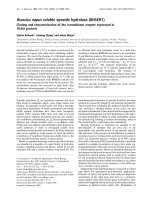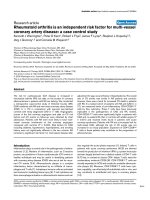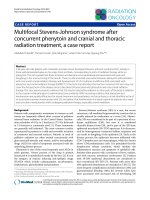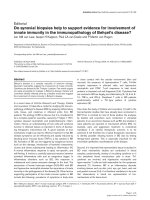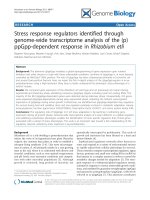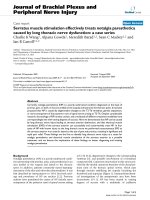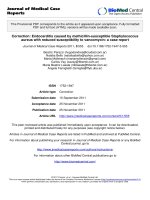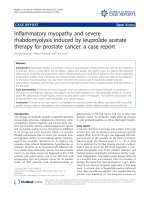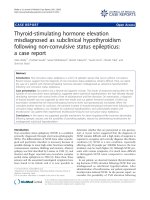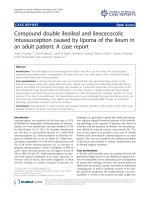Báo cáo y học: "Typhoid ulcer causing life-threatening bleeding from Dieulafoy''''s lesion of the ileum in a seven-year-old child: a case report" doc
Bạn đang xem bản rút gọn của tài liệu. Xem và tải ngay bản đầy đủ của tài liệu tại đây (866.3 KB, 5 trang )
JOURNAL OF MEDICAL
CASE REPORTS
Ezzat et al. Journal of Medical Case Reports 2010, 4:171
/>Open Access
CASE REPORT
© 2010 Ezzat et al; licensee BioMed Central Ltd. This is an Open Access article distributed under the terms of the Creative Commons
Attribution License ( which permits unrestricted use, distribution, and reproduction in
any medium, provided the original work is properly cited.
Case report
Typhoid ulcer causing life-threatening bleeding
from Dieulafoy's lesion of the ileum in a
seven-year-old child: a case report
Rajan Fuad Ezzat*
1
, Hiwa A Hussein
2
, Trifa Shawkat Baban
3
, Abbas Tahir Rashid
1
and Khaled Musttafa Abdullah
1
Abstract
Introduction: We describe a case of rare complication of typhoid fever in a seven-year-old child and review the
literature with regard to other rare causes of bleeding per rectum. Dieulafoy's lesion is an uncommon but important
cause of recurrent gastrointestinal bleeding. Dieulafoy's lesion located extragastrically is rare. We report a case of
typhoid ulcer with Dieulafoy's lesion of the ileum causing severe life-threatening bleeding and discuss the
management of this extremely uncommon entity.
Case presentation: As a complication of typhoid fever, a seven-year-old Kurdish girl from Northern Iraq developed
massive fresh bleeding per rectum. During colonoscopy and laparotomy, she was discovered to have multiple
bleeding ulcers within the Dieulafoy's lesion in the terminal ileum and ileocecal region.
Conclusion: Although there is no practical way of predicting the occurrence of such rare complications, we emphasize
in this case report the wide array of pathologies that can result from typhoid fever.
Introduction
Typhoid fever and paratyphoid fever is a systemic infec-
tion caused by Salmonella enterica, including S. enterica
serotype Typhi (S. typhi) and serotype Paratyphi (S. para-
typhi). Enteric fever is a faecal-oral transmissible disease
and thus occurs in an environment with overcrowding,
poor sanitation and untreated water [1].
Complications occur in 10 to 15% of patients and are
particularly likely in patients who have been ill for more
than two weeks. Many complications have been
described, of which gastrointestinal bleeding, intestinal
perforation, and typhoid encephalopathy are the most
important [1]. Gastrointestinal bleeding is the most com-
mon symptom and it occurs in up to 10% of patients. It
results from the erosion of a necrotic Peyer's patch
through the wall of an enteric vessel. In the majority of
cases, the bleeding is slight and resolves without the need
for blood transfusion. In 2% of cases, however, bleeding is
clinically significant and can be rapidly fatal if a large ves-
sel is involved. Intestinal (usually ileal) [1,2] perforation is
the most serious complication of the disease and it occurs
in 1 to 3% of hospitalized patients [1-3].
Intestinal bleeding in typhoid fever usually occurs from
the ulcers in the ileum or the proximal colon, and the
most common colonoscopic manifestations are multiple
variable-sized punched-out ulcerations. The shape of the
ulcers is usually ovoid with the longest diameter parallel
to the long axis of the gut, so that stricture formation
does not occur after healing. The edges are soft, swollen
and irregular, but not undermined. The floor is usually
smooth and is formed by the muscular coat. Near the
ileocecal valve, where perforation occurs more com-
monly, ulcers become deeper than elsewhere [2].
Although uncommon, sporadic cases of typhoid fever still
occur.
Involvement of the small intestine is nearly universal
[1]. Hemorrhage and intestinal perforation are the two
major complications of small intestinal typhoid infection.
Therapy for hemorrhaged small intestine in typhoid fever
is initially supportive, consisting of blood transfusions
and administration of antibiotics. In massive or recurrent
hemorrhage, consideration is given to surgical resection
of the involved small-intestinal segment. Operative man-
agement of the complications of small intestinal typhoid
* Correspondence:
1
Department of Surgery, Sulaimanyah Teaching Hospital, Sulaimanyah, Iraq
Full list of author information is available at the end of the article
Ezzat et al. Journal of Medical Case Reports 2010, 4:171
/>Page 2 of 5
infection has a high associated mortality rate [1,2]. Here
we report a case of typhoid ileitis with massive hemor-
rhage from diffuse punched-out ulcerations and erosions
in the terminal ileum successfully treated by surgical exci-
sion of the diseased part.
Case presentation
A seven-year-old Kurdish girl from northern Iraq pre-
sented to our hospital with fever, abdominal pain, nausea,
vomiting and diarrhea for one week duration, followed by
fresh bleeding per rectum after 10 days from her illness
for three days before her admission. She had history of
neither chronic medical disease nor surgical operation.
Her physical examination on admission revealed the fol-
lowing: pallor, BP = 80/50 mmhg, PR = 97 b/m, rapid res-
piration (shock state), temperature = 40.2 ˚C. Her
abdominal examination revealed mild splenomegaly with
diffuse abdominal tenderness mainly in the right lower
quadrant. Blood profile showed a hemoglobulin of 7.1 g/
dl, white blood cell of 4500/ml, and agglutinations for O.
salmonella antigens at 1:160. Culture from our patient
grew Salmonella typhi. An abdominal ultrasound of our
patient revealed splenomegaly.
Once she was admitted to our hospital's emergency
department, supportive measures were performed on her,
including intravenous line, blood transfusion (five pints)
and the administration of broad spectrum antibiotics in
the form of third generation cephalosporin (Ceftriaxone)
1 gm daily. An urgent colonoscopy was arranged for our
patient, which showed that her colon was full of fresh
blood. After suction and irrigation the terminal ileum of
our patient was intubated, which revealed multiple vari-
able size punched-out ileal ulcers up to 25 cm from the
ileocecal valve, as well as ulceration of the ileal mucosa
with characteristic dilated aberrant submucosal vessel
that erodes the overlying epithelium.
In the absence of a primary ulcer, Dieulafoy's lesion was
seen in the terminal ileum with oozing hemorrhage from
this lesion 10 cm away from the ileocecal valve (Figure 1).
The bleeding could not be controlled by endoscopic
hemostasis using thermal coagulation or any other endo-
scopic intervention. A decision was made accordingly for
urgent explorative laparotomy to save her life. An ileo-
colectomy (emergency limited segmental resection for a
known bleeding source) was also done on our patient
(Figure 2). Histology revealed this to be of the Dieulafoy
type of lesion in the distal ileum (Figure 3).
Our patient had a very smooth post-operative course.
Her hematochezia disappeared the next day and she was
discharged in good health within eight days. One month
later, she was completely asymptomatic. The biopsy spec-
imen of the distal 25 cm of her ileum located 20 cm from
her right colon had numerous irregular punched out-
ulcers, extensive inflammation, and focal suppuration
infiltrating mucosa and submucosa.
Macroscopic examination revealed a vascular malfor-
mation with a visible clot within. Microscopy revealed a
lesion comprising of thick-walled arteries and veins rep-
resenting an arteriovenous malformation (AVM). A
degree of thrombosis and recanalization was also
observed. The appearances were those of an AVM of the
Dieulafoy type. Ulcers were also revealed, and some of
them were deep. Mixed inflammatory cell infiltrate pre-
dominated the ulcers without caseous necrosis. The mes-
enteric lymph nodes of our patient revealed reactive sinus
hyperplasia (Figure 3).
Discussion
The percentage of patients that presented with lower gas-
trointestinal bleeding (GIB) in patients with typhoid
fever, whether clinically suspected or blood culture posi-
tive, was 2%. This is much lower than that reported in the
literature (10%) [1]. Most patients with lower GIB were
young [2]. Endoscopic demonstration of colonic and ter-
minal ileum lesions of typhoid by colonoscopy is scarcely
reported in the medical literature, as these examinations
are only advised when the etiological diagnosis is not yet
established.
Ulcerations generally occur in the terminal ileum,
cecum and the ascending colon, and rarely in the left side
of the colon [4]. Dieulafoy lesions rarely cause gastroin-
testinal hemorrhage. These lesions were first identified by
Gallard in 1884 and formally described by Dieulafoy in
1897. Macroscopically, AVM comprises a small pea-sized
lesion appearing as a mucosal defect with an artery pro-
truding from its base.
Histologically, a thick-walled arterial vessel is seen. This
is larger than the surrounding submucosal vessels and
runs below the muscularis mucosae. A similar appear-
ance has been reported throughout the gastrointestinal
tract. Although the pathogenesis is unclear, the lesion is
believed to be congenital in origin. Endoscopic diagnosis
of extragastric Dieulafoy's lesion can be difficult because
of its small size and obscure location. Increased aware-
ness and careful and early endoscopic evaluation follow-
ing the bleeding episode are the key to accurate diagnosis
[5]. In a large series from a tertiary care center in India,
out of 900 cases of upper GIB, only six (0.67%) were
caused by DL. The lesion was located within 6 cm of the
gastroesophageal junction in all cases [1].
Extragastric DLs are uncommon. In a review of over
100 cases of DLs, Veldhuyzen found no lesion of the duo-
denum [6]. Similar lesions have also been described in the
esophagus [7-9], duodenum, jejunum, colon and rectum
[8,10-12]. Extragastric DLs have been identified more fre-
quently in recent years because of increased awareness of
Ezzat et al. Journal of Medical Case Reports 2010, 4:171
/>Page 3 of 5
the condition [7,8]. In a large series of 89 patients with
DLs, the lesions were extragastric in a third of the cases.
The duodenum was the most common location (18%)
of extragastric DLs, followed by the colon (10%), jejunum
(2%) and the esophagus (2%) [8]. The pathology of the
lesion is essentially the same throughout the gastrointes-
tinal tract and is caused by an abnormally large calibre
persistent tortuous submucosal artery [13].
Conclusion
The endoscopic criteria proposed to define DL are: 1)
active arterial spurting or micropulsatile streaming from
a minute mucosal defect or through normal surrounding
mucosa; 2) visualization of a protruding vessel with or
without active bleeding within a minute mucosal defect
or through normal surrounding mucosa; and 3) fresh,
densely adherent clot with a narrow point of attachment
to a minute mucosal defect or to normal appearing
mucosa [14].
Meanwhile, several surgical options are used in the
management of patients with lower intestinal bleeding: 1)
emergency limited segmental resection for a known
bleeding source in continued severe bleeding (directed
segmental resection); 2) elective segmental resection for a
known bleeding source such as adenocarcinoma of the
colon or for rebleeding from a known lesion such as a
colon diverticulum; 3) emergency segmental colon resec-
tion for an unknown bleeding source (blind segmental
resection); and 4) emergency total abdominal colectomy
with ileorectal anastomosis (subtotal colectomy) for an
unknown bleeding location.
Several criteria have been used to recommend surgery
for patients with acute lower intestinal bleeding. Transfu-
sion requirements of >4 units during 24 hours and before
10 units overall have been used as indicators for surgical
intervention. These data support the importance of pur-
suing an aggressive approach to pre-operative localiza-
tion of the bleeding source.
Consent
Written informed consent was obtained from the par-
ents/guardian of our patient for publication of this case
Figure 1 Diffuse terminal ileal ulceration and angiomal formtion with oozing hemorrhage from these ulcers.
Figure 2 The surgical specimen after resection.
Ezzat et al. Journal of Medical Case Reports 2010, 4:171
/>Page 4 of 5
report and any accompanying images. A copy of the writ-
ten consent is available for review by the Editor-in-Chief
of this journal.
Competing interests
The authors declare that they have no competing interests.
Authors' contributions
RFE collected, analyzed and interpreted our patient's data, and assisted in the
endoscopy and performed the surgery of our patient. HH performed the
endoscopy and assisted in interpreting our patient's data. TSB performed the
histological examination of the surgical specimen and assisted in interpreting
our patient's data. ATR assisted in the operation and in analyzing our patient's
data. KMA received our patient and assisted in collecting our patient's data. All
authors read and approved the final manuscript.
Author Details
1
Department of Surgery, Sulaimanyah Teaching Hospital, Sulaimanyah, Iraq,
2
Department of Medicine, Sulaimanyah Teaching Hospital, Sulaimanyah, Iraq
and
3
Department of Pathology, Sulaimanyah Teaching Hospital, Sulaimanyhah,
Iraq
References
1. Parry CM, Hien TT, Dougan G, White NJ, Farrar JJ: Typhoid fever. N Engl J
Med 2002, 347:1770-1782.
2. Bitar RE, Tarpley J: Intestinal perforation in typhoid fever: a historical
and state-of-the-art review. Rev Infect Dis 1985, 7:257-271.
3. Van Basten JP, Stockenbrugger R: Typhoid perforation: a review of the
literature since 1960. Trop Geogr Med 1994, 46:336-339.
4. Hepps K, Sutton FM, Goodcame RW: Multiple left-sided colon ulcers due
to typhoid fever. Gastrointest Endosc 1991, 37:479-480.
5. Al-Mishlab T, Amin AM, Ellul JM: Dieulafoy's lesion: an obscure cause of
GI bleeding. J R Coll Surg Edinb 1999, 44:222-225.
6. Veldhuyzen van Zanten SJ, Bartelsman JF, Schipper ME, Tytgat GN:
Recurrent massive hematemesis from Dieulafoy vascular
malformation: a review of 101 cases. Gut 1986, 27:213-222.
7. Ertekin C, Barbaros U, Taviloglu K, Guloglu R, Kasoglu A: Dieulafoy's lesion
of esophagus. Surg Endosc 2002, 16:219.
8. Norton ID, Petersen BT, Sorbi D, Balm RK, Alexander GL, Gostout CJ:
Management and long-term prognosis of Dieulafoy lesion. Gastrointest
Endosc 1999, 50:762-767.
Received: 4 November 2009 Accepted: 3 June 2010
Published: 3 June 2010
This article is available from: 2010 Ezzat et al; licensee BioMed Central Ltd. This is an Open Access article distributed under the terms of the Creative Commons Attribution License ( which permits unrestricted use, distribution, and reproduction in any medium, provided the original work is properly cited.Journal of Medical Case Repo rts 2010, 4:171
Figure 3 The arteriovenous malformation in different sections and views.
Ezzat et al. Journal of Medical Case Reports 2010, 4:171
/>Page 5 of 5
9. Anireddy D, Timberlake G, Seibert D: Dieulafoy's lesion of the
esophagus. Gastrointest Endosc 1993, 39:604.
10. Pollack R, Lipsky H, Goldberg RI: Duodenal Dieulafoy's lesion.
Gastrointest Endosc 1993, 39:820.
11. Choudari CP, Palmer KR: Dieulafoy's lesion of the duodenum; successful
endoscopic therapy. Endoscopy 1993, 25:371.
12. Lee YT, Walmsley RS, Leong RW, Sung JJ: Dieulafoy's lesion. Gastrointest
Endosc 2003, 58:236.
13. Gadenstatter M, Wetscher G, Crookes PF, Mason RJ, Schwab G, Pointner R:
Dieulafoy's disease of the large and small bowel. J Clin Gastroenterol
1998, 27:169-172.
14. Dy NM, Gostout CJ, Balm RK: Bleeding from the endoscopically
identified Dieulafoy lesion of the proximal small intestine and colon.
Am J Gastroenterol 1995, 90:108-111.
doi: 10.1186/1752-1947-4-171
Cite this article as: Ezzat et al., Typhoid ulcer causing life-threatening bleed-
ing from Dieulafoy's lesion of the ileum in a seven-year-old child: a case
report Journal of Medical Case Reports 2010, 4:171
